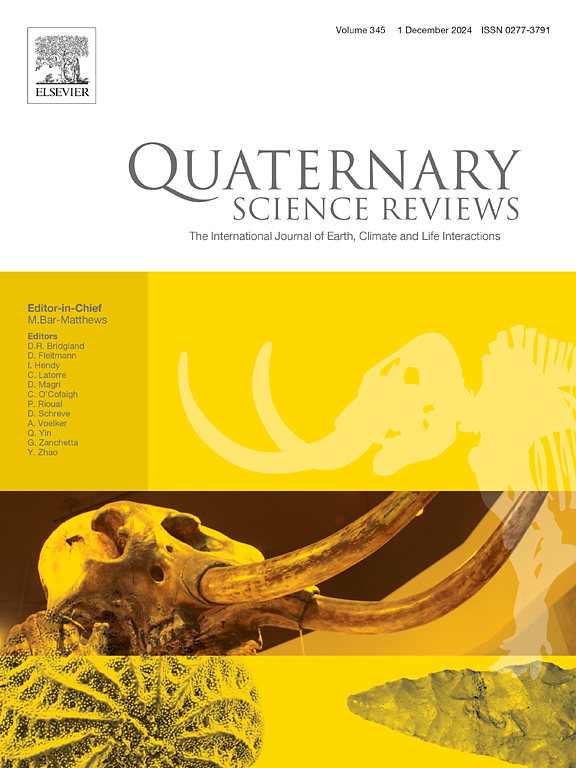阿尔辛冰川(西欧阿尔卑斯山脉)的全新世历史:由气候驱动和由岩石雪崩调节的振荡的详细10Be记录
IF 3.3
1区 地球科学
Q1 GEOGRAPHY, PHYSICAL
引用次数: 0
摘要
最近,利用10Be陆地宇宙成因核素(TCN)暴露定年法对阿尔卑斯冰川至早全新世(EH)冰川变化进行了彻底的研究。相比之下,由于在小冰期(LIA)之前保存的冰碛物稀少,关于新冰川期(~ 4.2-0.14 ka)冰川所达到的空间范围的知识仍然是零碎的。此外,尽管对被碎屑覆盖的冰川或岩石冰川留下的地貌印记的气候意义进行了越来越多的研究,但与无碎屑冰川留下的地貌印记直接比较往往是不可能的。在这里,我们提供了一个前所未有的大的TCN数据集,该数据集限制了法国阿尔卑斯山阿尔辛冰川从冰川期结束到小冰期结束的行为。静止的冰碛存在于西部和东部的山谷中,这些山谷以前是由冰体的两个独立分支占据的,距离现存的冰川锋面最远可达3公里。再往上坡,阿尔辛冰川的前场以两个突出的地貌复合体为特征。第一个是具有同心脊的奇特地貌,以前被解释为冰碛岩冰川。它是由一个广阔而混乱的巨石区构成的,在冰川最接近的部分,它被第二个突出的特征覆盖,一个大型的无植被的侧面和正面复合冰碛。年代学结果表明,在11.88±0.43 ka和11.10±0.37 ka之间,最远端的冰碛集证明了西部冰川分支的5次振荡。对这些位置的空间范围的鲁棒约束表明,冰川平衡线高度相对于小雪区在224 m至169 m之间下降。最内层的EH复合体被解释为与北极前涛动(PBO)的区域表达有关。先前解释的冰碛岩衍生的岩石冰川被发现更像是在覆盖冰体东部分支和周围地面的岩石雪崩之后沉积的冰碛复合体。这一灾难性事件发生在10.71±0.42 ka,在前寒武纪的第一次显著变暖期间,由框架巨石场沉积物的年代测定显示。由此产生的冰碛复合体的脊的年代测定显示,随后前进了约1250米,在10.25±0.42 ka达到顶峰,随后在LIA范围外被碎片覆盖的东舌持续到9.52±0.43 ka。相比之下,在此期间,没有明显的冰碛沉积由西部冰川分支,不受岩石雪崩的影响。与阿尔卑斯山脉其他地方一样,没有发现与中全新世(8.2-4.2 ka)相对应的10Be巨石年龄。冰川-近端冰碛复合体的年代测定使其沉积属于新冰川期。该特征的就位不迟于3.74±0.02 ka。随后的冰川高峰时期在冰川两侧沉积了一个可追溯到2.69±0.14 ka的till单元。公元1.67±0.05 ka,出现了第一次lia样推进。在小冰期,早进(eLIA)在650±30 a前沉积了最外层的新冰期前缘冰碛。最后,最深处保存的侧冰碛沉积于冰期末期,距今170±10 a。据我们所知,arsin冰川记录是阿尔卑斯山地区最详细的10倍全新世冰川年表,与该地区现有的其他冰川记录非常吻合。我们认为,除了直接由气候驱动的冰川推进和相应的EH和新冰川期冰缘冰碛沉积外,暖期相关的环头壁失稳导致EH发生了大规模的岩石雪崩,将大量碎屑带到了冰川的一部分。这种过量的供应——估计体积为8.4 × 106立方米——导致东部冰川分支演变成一个被大量碎屑覆盖的舌状体,记录了在LIA范围外约10.3至9.5 ka之间与气候相关的振荡。本文章由计算机程序翻译,如有差异,请以英文原文为准。
The Holocene history of Arsine Glacier (Western European Alps): a detailed 10Be record of oscillations driven by climate and modulated by rock avalanches
Lateglacial to Early Holocene (EH) glacier variations in the Alps have recently been thoroughly refined using 10Be terrestrial cosmogenic nuclide (TCN) exposure dating of moraines. In contrast, knowledge of the spatial extent reached by glaciers during the Neoglacial period (∼4.2–0.14 ka) is still fragmentary because of the scarcity of preserved moraines predating the Little Ice Age (LIA). In addition, although the climatic meaning of the geomorphological imprints left by debris-covered glaciers or rock glaciers is increasingly investigated, direct comparison with those of debris-free glaciers is often not possible. Here, we provide an unprecedentedly large TCN dataset for the region (n = 53) constraining the behaviour of Arsine Glacier, French Alps, from the end of the Lateglacial to the end of the LIA. Stadial moraines are present in both the western and eastern valleys formerly occupied by two separate branches of the ice body, up to c. 3 km from the extant glacier front. Further upslope, the forefield of Arsine Glacier is characterized by two prominent geomorphic complexes. The first is a peculiar landform with concentric ridges, previously interpreted as a moraine-derived rock glacier. It is framed by an extensive and chaotic boulder field and is overtopped – in the most glacier-proximal part – by the second outstanding feature, a large complex of unvegetated lateral and frontal composite moraines. The chronological results indicate that the most distal moraine sets testify to five oscillations of the western glacier branch between 11.88 ± 0.43 ka and 11.10 ± 0.37 ka. Robust constraints on the spatial extent of these positions show depression of the glacier equilibrium line altitude ranging from 224 m to 169 m relative to the LIA. The innermost EH complex dated here is interpreted as being related to the regional expression of the Preboreal Oscillation (PBO). The previously interpreted moraine-derived rock glacier was found to rather represent a moraine complex deposited following a rock avalanche covering the eastern branch of the ice body and the surrounding floor. This catastrophic event occurred at 10.71 ± 0.42 ka, during the first significant warming of the Preboreal period, as shown by dating of the framing boulder field deposit. Dating of the ridges of the resulting moraine complex shows a subsequent advance of c. 1250 m peaking at 10.25 ± 0.42 ka, followed by persistence of the debris-covered eastern tongue outboard the LIA extent until 9.52 ± 0.43 ka. By contrast, during this interval no prominent moraine was deposited by the western glacier branch, not affected by the rock avalanche. Like elsewhere in the Alps, no 10Be boulder ages corresponding to the Mid-Holocene (8.2–4.2 ka) were found. Dating of the glacier-proximal moraine complex allows assigning its deposition to the Neoglacial period. The emplacement of this feature had started no later than 3.74 ± 0.02 ka. A subsequent period of glacier maxima deposited a till unit dated on both sides of the glacier at 2.69 ± 0.14 ka. During the Common Era, the first LIA-like advance occurred at 1.67 ± 0.05 ka. During the LIA, an early advance (eLIA) deposited the outermost Neoglacial frontal moraine 650 ± 30 a ago. Finally, the innermost preserved lateral moraine was deposited at the end of the LIA, 170 ± 10 a ago. The Arsine Glacier record is, to our knowledge, the most detailed 10Be-based Holocene-long glacier chronology in the Alps, and agrees well with other existing glacier records in the region. We propose that, apart from the directly climate-driven glacier advances and corresponding ice-marginal moraine deposits of the EH and the Neoglacial, a large EH rock avalanche occurred following warm-period-related destabilization of the cirque headwalls, bringing large amount of debris onto one part of the glacier. This excessive supply – estimated to a volume of c. 8.4 × 106 m3 – led the eastern glacier branch to evolve into a heavily debris-covered tongue that recorded climate-related oscillations between ∼10.3 and 9.5 ka outboard the LIA extent.
求助全文
通过发布文献求助,成功后即可免费获取论文全文。
去求助
来源期刊

Quaternary Science Reviews
地学-地球科学综合
CiteScore
7.50
自引率
15.00%
发文量
388
审稿时长
3 months
期刊介绍:
Quaternary Science Reviews caters for all aspects of Quaternary science, and includes, for example, geology, geomorphology, geography, archaeology, soil science, palaeobotany, palaeontology, palaeoclimatology and the full range of applicable dating methods. The dividing line between what constitutes the review paper and one which contains new original data is not easy to establish, so QSR also publishes papers with new data especially if these perform a review function. All the Quaternary sciences are changing rapidly and subject to re-evaluation as the pace of discovery quickens; thus the diverse but comprehensive role of Quaternary Science Reviews keeps readers abreast of the wider issues relating to new developments in the field.
 求助内容:
求助内容: 应助结果提醒方式:
应助结果提醒方式:


